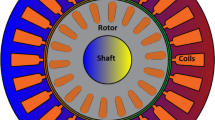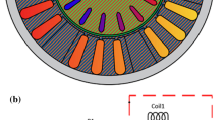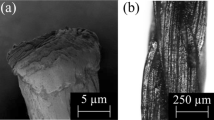Abstract
Nanocarbon-based materials, including carbon nanotubes, have been considered to replace conventional metals for electrical wires, mainly due to their exceptional properties and the rapid increase in global demand for better electrical energy generation, transmission, and conversion. However, the numerical examination of the performance of the electrical machine with different novel carbon nano-based materials is still challenging. Advanced carbon-based materials are proposed as a hypothetical winding material to initiate discussion and examine potential possibilities. This study thoroughly examines and compares different carbon nanomaterials for winding material in a permanent magnet generator. The generator's performance was investigated for three stator winding materials: carbon nanotube (CNT) yarn, carbon nanotube aluminum composite (Al/CNT), and carbon nanotube copper composite (Cu/CNT). A finite-element model of a machine is used to provide the performance study and focuses on the machine-generated voltages, currents, and efficiencies. The simulation was carried out using COMSOL Multiphysics software. The findings illustrate that CNT yarn, Al/CNT, and Cu/CNT composite wire as a winding produces maximum voltages of 15.2, 50.1, and 70 V, respectively, when rotated at 100 rpm. It is observed that the proposed use of carbon nanomaterials is being explored as a possible way to replace the pure metal-based winding of the electrical machine. We conclude that carbon nanotube copper composite wire may be better for winding machine applications than carbon nanotube yarn. These results may be used to design a permanent magnet generator for industrial applications based on their requirements.












Similar content being viewed by others
Data availability statement
The co-author provides some of the data models or algorithms that support this work's findings upon reasonable request.
References
Srivastava, A.K., Basu, S.: Exploring the performance of a dielectric elastomer generator through numerical simulations. Sens. Actuators A Phys. 319 (2021). https://doi.org/10.1016/j.sna.2020.112401
Seo, S.W., Shin, K.H., Koo, M.M., Hong, K., Yoon, I.J., Choi, J.Y.: Experimentally verifying the generation characteristics of a double-sided linear permanent magnet synchronous generator for Ocean Wave Energy conversion. IEEE Trans. Appl. Supercond. 30 (2020). https://doi.org/10.1109/TASC.2020.2990827
Paulo e Silva, A.G., Basílio Sobrinho, J.M., da Rocha Souto, C., Ries, A., de Castro, A.C.: Design, modelling and experimental analysis of a piezoelectric wind energy generator for low-power applications. Sens. Actuators A Phys. 317 (2021). https://doi.org/10.1016/j.sna.2020.112462
Vaimann, T., Kallaste, A., Kilk, A., Belahcen, A.: Magnetic properties of reduced Dy NdFeB permanent magnets and their usage in electrical machines. IEEE AFRICON Conf. (2013). https://doi.org/10.1109/AFRCON.2013.6757787
Bhuiyan, N.A., McDonald, A.: Optimization of offshore direct drive wind turbine generators with consideration of permanent magnet grade and temperature. IEEE Trans. Energy Convers. 34, 1105–1114 (2019). https://doi.org/10.1109/TEC.2018.2879442
Cheng, G.G., Jiang, S.Y., Li, X., Li, K., Zhang, Z.Q., Ding, J.N., Wang, Y., Yuan, N.Y.: A contact electrification based wind generator. Sens. Actuators A Phys. 280, 252–260 (2018). https://doi.org/10.1016/j.sna.2018.07.043
Shin, H.S., DIaz, M.A., Velasco, M., Awaji, S.: Performance Evaluation of Practical REBCO Coated Conductor Tapes for Superconducting Wind Power Coils. IEEE Trans. Appl. Supercond. 30 (2020). https://doi.org/10.1109/TASC.2020.2970383
Sullivan, C.R.: Aluminum windings and other strategies for high-frequency magnetics design in an era of high copper and energy costs. IEEE Trans. Power Electron. 23, 2044–2051 (2008). https://doi.org/10.1109/TPEL.2008.925434
Lekawa-Raus, A., Patmore, J., Kurzepa, L., Bulmer, J., Koziol, K.: Electrical properties of carbon nanotube based fibers and their future use in electrical wiring. Adv. Funct. Mater. 24, 3661–3682 (2014). https://doi.org/10.1002/adfm.201303716
Li, H., Banerjee, K.: High-frequency effects in carbon nanotube interconnects and implications for on-chip inductor design. Tech. Dig. Int. Electron Devices Meet. IEDM. (2008). https://doi.org/10.1109/IEDM.2008.4796741
Haynes, W.M.: CRC handbook of chemistry and physics. CRC press (2014)
Sundaram, R.M., Sekiguchi, A., Sekiya, M., Yamada, T., Hata, K.: Copper/carbon nanotube composites: Research trends and outlook. R. Soc. Open Sci. 5 (2018). https://doi.org/10.1098/rsos.180814
Behabtu, N., Young, C.C., Tsentalovich, D.E., Kleinerman, O., Wang, X., Ma, A.W.K., Bengio, E.A., Ter Waarbeek, R.F., De Jong, J.J., Hoogerwerf, R.E., Fairchild, S.B., Ferguson, J.B., Maruyama, B., Kono, J., Talmon, Y., Cohen, Y., Otto, M.J., Pasquali, M.: Strong, light, multifunctional fibers of carbon nanotubes with ultrahigh conductivity. Sci. 339 (80), 182–186 (2013). https://doi.org/10.1126/science.1228061
Kurzepa, L., Lekawa-Raus, A., Patmore, J., Koziol, K.: Replacing copper wires with carbon nanotube wires in electrical transformers. Adv. Funct. Mater. 24, 619–624 (2014). https://doi.org/10.1002/adfm.201302497
Lekawa-Raus, A., Gizewski, T., Patmore, J., Kurzepa, L., Koziol, K.K.: Electrical transport in carbon nanotube fibres. Scr. Mater. 131, 112–118 (2017). https://doi.org/10.1016/j.scriptamat.2016.11.027
Hassan, A., Abbas, S., Jie, L., Youming, L., Quanfang, C.: Investigation of the Advanced Novel Carbon Nanotube (CNT) Yarn and carbon nanotube aluminum/copper composite windings for a single-phase induction motor. Arab. J. Sci. Eng. (2022). https://doi.org/10.1007/s13369-022-07060-5
Hassan, A., Quanfang, C., Abbas, S., Jie, L., Youming, L., Hussain, F.: Comparative thermal analysis of carbon nanotubes and their metal composites with copper and aluminum as winding material in induction motor. J. Electr. Eng. Technol. (2022). https://doi.org/10.1007/s42835-022-01072-9
Zhang, S., Nguyen, N., Leonhardt, B., Jolowsky, C., Hao, A., Park, J.G., Liang, R.: Carbon-Nanotube-Based Electrical Conductors: Fabrication, Optimization, and Applications. Adv. Electron. Mater. 5, (2019). https://doi.org/10.1002/aelm.201800811
Jarosz, P., Schauerman, C., Alvarenga, J., Moses, B., Mastrangelo, T., Raffaelle, R., Ridgley, R., Landi, B.: Carbon nanotube wires and cables: near-term applications and future perspectives. Nanoscale 3, 4542–4553 (2011)
Alvarenga, J.: Carbon nanotube materials for aerospace wiring, Rochester Institute of Technology (2010)
Rallabandi, V., Taran, N., Ionel, D.M., Eastham, J.F.: On the feasibility of carbon nanotube windings for electrical machines—case study for a coreless axial flux motor. ECCE 2016 IEEE Energy Convers. Congr. Expo. Proc. (2016). https://doi.org/10.1109/ECCE.2016.7855306
Mceuen, P.L., Fuhrer, M.S., Park, H.: Single-walled carbon nanotube electronics. IEEE Trans. Nanotechnol. 1, 78–85 (2002)
Lu, W., Zu, M., Byun, J.H., Kim, B.S., Chou, T.W.: State of the art of carbon nanotube fibers: Opportunities and challenges. Adv. Mater. 24, 1805–1833 (2012). https://doi.org/10.1002/adma.201104672
Hjortstam, O., Isberg, P., Söderholm, S., Dai, H.: Can we achieve ultra-low resistivity in carbon nanotube-based metal composites? Appl. Phys. A Mater. Sci. Process. 78, 1175–1179 (2004). https://doi.org/10.1007/s00339-003-2424-x
Li, Q., Li, Y., Zhang, X., Chikkannanavar, S.B., Zhao, Y., Dangelewicz, A.M., Zheng, L., Doorn, S.K., Jia, Q., Peterson, D.E., Arendt, P.N., Zhu, Y.: Structure-dependent electrical properties of carbon nanotube fibers. Adv. Mater. 19, 3358–3363 (2007). https://doi.org/10.1002/adma.200602966
Shin, S.E., Choi, H.J., Bae, D.H.: Electrical and thermal conductivities of aluminum-based composites containing multi-walled carbon nanotubes. J. Compos. Mater. 47, 2249–2256 (2013). https://doi.org/10.1177/0021998312456891
Liu, Z.Y., **ao, B.L., Wang, W.G., Ma, Z.Y.: Tensile strength and electrical conductivity of carbon nanotube reinforced aluminum matrix composites fabricated by powder metallurgy combined with friction stir processing. J. Mater. Sci. Technol. 30, 649–655 (2014). https://doi.org/10.1016/j.jmst.2014.04.016
Genova, V., Gozzi, D., Latini, A.: High-temperature resistivity of aluminum–carbon nanotube composites. J. Mater. Sci. 50, 7087–7096 (2015). https://doi.org/10.1007/s10853-015-9263-y
Subramaniam, C., Yamada, T., Kobashi, K., Sekiguchi, A., Futaba, D.N., Yumura, M., Hata, K.: One hundred fold increase in current carrying capacity in a carbon nanotube-copper composite. Nat. Commun. 4, (2013). https://doi.org/10.1038/ncomms3202
Jayathilaka, W.A.D.M., Chinnappan, A., Ramakrishna, S.: A review of properties influencing the conductivity of CNT/Cu composites and their applications in wearable/flexible electronics. J. Mater. Chem. C. 5, 9209–9237 (2017). https://doi.org/10.1039/c7tc02965a
C. Subramaniam, T. Yamada, Kobashi, K., Sekiguchi, A., Futaba, D. N., Yumura, M.: One-hundred-fold increase in current carrying capacity in a carbon nanotube–copper composite. Nat. Commun. 4, 2202 (2013)
de Groh III, H.C.: Consideration of Conductive Motor Winding Materials at Room and Elevated Temperatures. [Report]. (2015)
Still, A.: Principles of electrical design: DC and AC generators. New York: McGraw-Hill (1921)
Pyrhönen, J., Montonen, J., Lindh, P., Vauterin, J.J., Otto, M.J.: Replacing copper with new carbon nanomaterials in electrical machine windings. Int. Rev. Electr. Eng. 10, 12–21 (2015). https://doi.org/10.15866/iree.v10i1.5253
Acknowledgements
SWJTU's foundation funded this research, and the first author was awarded a CSC Fellowship.
Author information
Authors and Affiliations
Contributions
AH: Conceptualization, Methodology, Software, Formal analysis, Resources, Writing—Original Draft. CQ: Supervision, Conceptualization, Review. Sajid Abbas: Software, Writing—Original Draft, Software, Investigation, Review & Editing, Data Curation, Revision. HA: Review, Editing, Revision. Luo Youming: Resources, Validation. LJ: Software, Review.
Corresponding authors
Ethics declarations
Conflict of interest
The authors declare that they have no conflicts of interest to report regarding the present study.
Additional information
Publisher's Note
Springer Nature remains neutral with regard to jurisdictional claims in published maps and institutional affiliations.
Rights and permissions
Springer Nature or its licensor (e.g. a society or other partner) holds exclusive rights to this article under a publishing agreement with the author(s) or other rightsholder(s); author self-archiving of the accepted manuscript version of this article is solely governed by the terms of such publishing agreement and applicable law.
About this article
Cite this article
Hassan, A., Quanfang, C., Abbas, S. et al. Exploring the electrical performance of advanced and environmental-friendly novel nanomaterial wires in generator winding through finite element analysis. J Comput Electron 22, 17–28 (2023). https://doi.org/10.1007/s10825-022-01965-y
Received:
Accepted:
Published:
Issue Date:
DOI: https://doi.org/10.1007/s10825-022-01965-y




